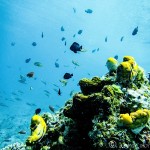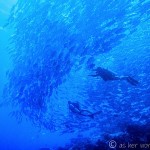It’s turtle time!
After spending all day lounging on the beach, dusk has arrived and soon turtle mommas will begin to lay eggs on the shores of Turtle Island (aka Selingan Island). Conservation employees will monitor this process and then dig up eggs to rebury them in the hatchery:



The eggs incubate for about two months before hatching. And since new eggs are buried every night, that means a new group of turtles — buried two months prior — will hatch every night. This usually happens after sunset and, sure enough, we notice the first hatchling pop up just before dinner. Can you spot him below?

Before the night’s activities officially begin, we pay a visit to an exhibit in the main hall. There’s a short movie about the turtle life cycle.


Let’s talk about their life cycle because I think it’s fascinating.
As shown above, baby turtles hatch about two months after their mother has laid a batch of eggs. They immediately move into the ocean and are either quickly eaten by predators or survive long enough to grow into maturity over several decades. Marine biologists know very little about this part of the cycle. Turtles may swim thousands of miles from the beach where they hatched during these “teenage” years, but it’s hard to track.
Once they reach maturity, turtles begin to mate. (At this point in the video we watched a group of male turtles gang rape a female to the point where she drowned because she couldn’t come up for air… we were all horrified.) Turtles are philopatric creatures, meaning they return to lay eggs in the general area — or sometimes exact same beach — where they hatched decades earlier. They can do this because they have highly magnetic sensitivities that allow them to navigate longitude with no visual markers. This blows my mind.
Female turtles lay eggs every 2 to 4 years, typically returning to the very same beach each time to deposit the eggs. They lay eggs anywhere from 1 to 8 times per pregnancy. This happens at night — they climb ashore and dig a hole about 18 inches deep, lay approximately 50-200 eggs, and then cover up the hole before returning to the sea. Once breeding season is over, they return to their feeding sites — often hundreds of miles away — until a few years later when they breed again.

(image via)
Here’s a look at what the hole looks like under the sand as the hatchings begin to emerge:

We are allowed to view only ONE turtle lay eggs so as to disturb as few as possible. The conservationists survey the beach and will lead us out, supervised, when the time comes.
In the meantime we keep vigil over the hatching area, our eyes peeled for newly hatched babies.


Tonight’s batch of collected eggs will be buried below:


We spot a few more babies trying to escape to the ocean. Conservationists gather them as they pop up and release them to the sea — a process we’ll witness in greater detail at the end of the night.



Word comes that there is a female laying eggs on the beach!
In fact, as we are ushered to the exact spot, I see MANY more momma turtles doing the same thing along the shore — but we are told to leave them alone (no photos) and proceed straight to the designated turtle so as not to disturb the others.
Once we are gathered around, our guide explains what is happening as another employee measures and watches over the female turtle. We are allowed to take photos but without flash, and we must whisper and keep talking to a minimum.

The mother turtle is in something of a trance as she lays eggs. We learned this from the video earlier and it’s clear in person. She barely makes a sound and her eyes are half-mast as the eggs — about the size of a ping pong ball — drop into the hole below.

This is something I will remember for the rest of my life. The experience itself is incredibly memorable, but then we’re greeted with an additional sight — flashes of lightening at the horizon (no rain). Several times a minute the sky lights up with a blinding flash and illuminates clouds. It is otherworldly.



The conservation worker measures the female and notes that she has a tag on her, which indicates that she has given birth on this very beach before.




He collects all of her eggs in that bucket and we return to the hatchery.


The eggs are buried and then protected by green netting.




This marker indicates the date (September 6th) and the number of eggs buried (109).


Another FASCINATING turtle fact is that their gender is determined by temperature. So the eggs buried together will either be all male or all female depending on the shade coverage in that particular area of the hatchery.

Our last adventure of the evening is releasing baby turtles that have just hatched. We carry a batch down to the ocean and prepare to send them off.

They’re pretty anxious to meet their new home.


Within a minute, all of the hatchlings have made their way into the ocean.

This shot isn’t perfect but I love the lightening flash in the background:

I stick around a tad longer on the beach to snap another lightening shot:

If you’re looking for more info on this Turtle Island experience, Peter at BeachMeter.com has shared stories and photos of his time there.
It has been so satisfying to write about this experience and share photos. Should you find yourself in a part of the world that offers a similar experience (there are several spots in Indonesia, Malaysia, and beyond), seek it out at all costs! You won’t regret it.







This is really beautiful and special!
The lightening pictures are crazy! Good timing on those shots! Neat!
Thank you! RE: the lightening, it happened frequently enough that I could stand there waiting for the next strike, my finger poised above the shutter button. Between what was happening on land and in the sky, nature put on quite a show that night!
Hi Erica! Can you give me any advice?
Can you give me any advice?
I am planning my trip to Malasya and I don’t want to miss this experience but… It is so expensive! When did u go? How much was it? I am going in August and maybe everything is going to be full…
Thank you!!
I got a ticket at the last minute on the morning of departure (they told me to call them at 8am and they’d let me know if anyone cancelled — thankfully someone did) and I paid the full price. Actually, there was another person from my hostel who wanted to do it too, so we split the full price. Unfortunately I don’t have better advice for you, as I did not try to book it in advance! But hopefully they are not 100% full for August and can squeeze you in? If your dates are flexible, even better. It was worth the effort to get there! And if they are fully booked, there are other places around Southeast Asia that have similar programs (hatchery, baby turtle release on the beach) if you Google them. Good luck!